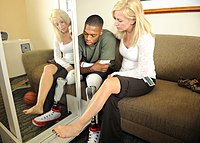
Photo from wikipedia
Background Stroke is one of the most frequent causes of death and disability worldwide. It is accompanied by the impaired motor function of the upper extremities in over 69% of… Click to show full abstract
Background Stroke is one of the most frequent causes of death and disability worldwide. It is accompanied by the impaired motor function of the upper extremities in over 69% of patients up to hemiplegia in the following 5 years in 56% of cases. This condition often is characterized by chronic poststroke pain, difficult to manage, further worsening quality of life. Poststroke pain occurs within 3–6 months. Robot-assisted neurorehabilitation using the Automatic Recovery Arm Motility Integrated System (ARAMIS) has proven efficacy in motor function recovery exploiting the movements and the strength of the unaffected arm. The rationale of the ROBOCOP (ROBOtic Care of Poststroke pain) randomized trial is the assessment of the impact of robot-assisted functional and motor recovery on the prevention of poststroke pain. Methods A total of 118 patients with hemiplegic arms due to stroke will be enrolled and randomly allocated with a 1:1 ratio to ARAMIS or conventional neurorehabilitation group. After a baseline screening at hospital discharge, ARAMIS or conventional rehabilitation will be performed for 8 weeks. The primary endpoint is the prevention of the development of poststroke pain and the secondary endpoints are prevention of spasticity and efficacy in clinical motor rehabilitation. The primary outcome measures consist in the visual analog scale and the doleur neuropatique 4 and the secondary outcome measures include: the Modified Ashworth Scale, the Resistance to Passive movement Scale; the Upper Extremity Subscale of the Fugl–Meyer Motor Assessment; the Action Research Arm Test; the Barthel Index for activities of daily living; and the magnetic resonance imaging (MRI) recovery-related parameters. After baseline, both primary and secondary outcome measures will be performed in the following time points: 1 month after stroke (t1, half of the rehabilitation); 2 months after stroke (t2, after rehabilitation); and 3 months (t3) and 6 months (t4) after stroke, critical for poststroke pain development. Discussion This is the first clinical trial investigating the efficacy of robot-assisted neurorehabilitation using ARAMIS on poststroke pain prevention. This study could remarkably improve the quality of life of stroke survivors.
Journal Title: Frontiers in Neurology
Year Published: 2022
Link to full text (if available)
Share on Social Media: Sign Up to like & get
recommendations!